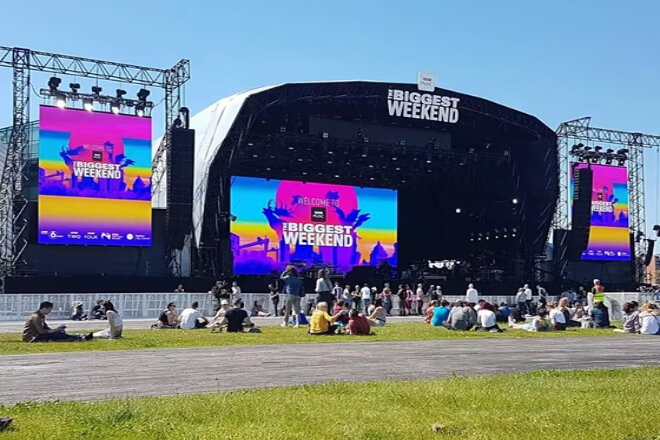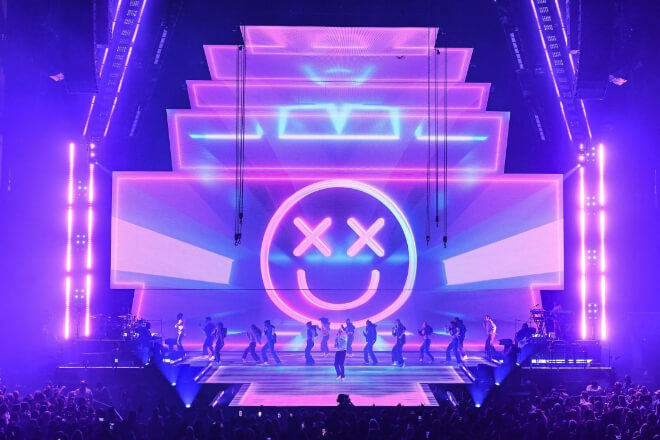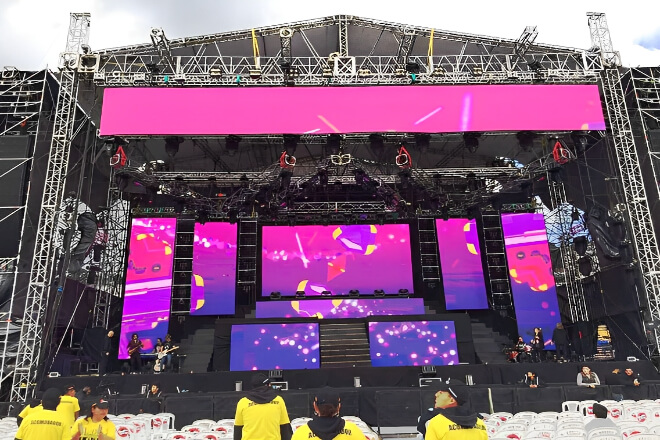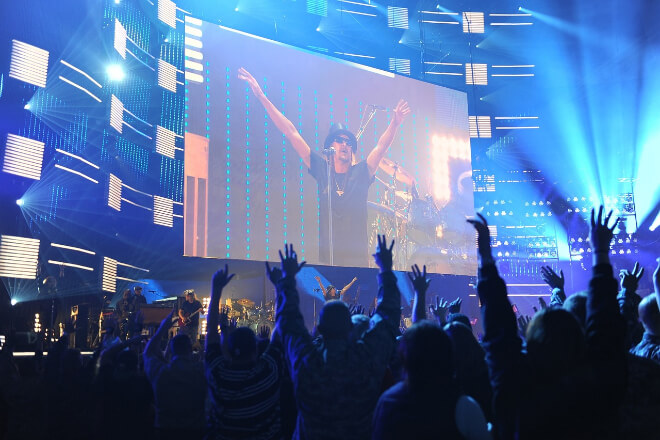소개

Outdoor music festivals and carnivals are incredibly popular these days! Just imagine thousands of people gathering together, dancing to the music, and enjoying the joyful atmosphere—how exciting!
However, to make these events even more exciting, music alone isn’t enough; they also need cool visual effects. This is where LED 디스플레이 come in handy.
목차
1. Characteristics of Outdoor Music Festivals and Carnivals

1) Large-Scale Events and Audiences
Outdoor music festivals and carnivals typically attract tens of thousands of spectators, including locals and tourists. For example, Europe’s Glastonbury Festival attracts over 200,000 people annually.
For such large-scale events, stage information, program schedules, and even safety instructions must be clearly visible to audiences from a distance.
Therefore, large screens are often used to ensure everyone can follow the action.
2) Creating an Atmosphere
The music itself delivers an auditory impact, but it’s the visuals that truly immerse the audience.
Electronic music festivals often use LED stage backdrops, dynamic lighting, and smoke effects to create a sense of immersion in a world of flowing light and shadow.
This combination of sound, light, and electricity not only makes the performance more impressive but also elevates the audience’s spirits to the music.
3) Diversity and variability of events
Music festivals and carnivals offer diverse programs: interactive children’s performances in the morning, street dance competitions in the afternoon, and even brand interaction areas.
With the constant switching of programs, display equipment must be able to quickly adjust content to keep the audience fresh and not miss any exciting moments.
2. Analysis of the Compatibility of LED Displays with Outdoor Music Festivals and Carnivals

At music festivals or carnivals, audiences often look forward to stunning visuals. LED displays can achieve visual effects that traditional 단계 sets cannot:
High-definition images, dazzling animations, dynamic backgrounds, and even real-time capture of audience interaction.
For example, at electronic music festivals, large screens on either side of the stage synchronise dynamic lighting effects with audience selfies or interactions, allowing even those at a distance to experience the vibrant atmosphere.
This not only enhances the viewing experience but also makes the entire event appear more modern and high-energy, encouraging photo-taking and social media sharing.
For organisers, LED displays are not just stage decorations; they are also powerful tools for information dissemination and interaction.
They can be used to display performance schedules, program flow, interactive voting results, and even provide important reminders in emergency situations.
For example, at some carnivals, if the order of a performance is adjusted at short notice, LED displays can instantly update the information, preventing audience anxiety or missed performances.
LED screens also enhance interactivity: audiences can see their own real-time performances on screen or participate in voting and games, making the event more of an immersive experience than just a viewing experience.
LED screens also bring commercial value to events. They can serve as a showcase for sponsors, enabling advertising, brand interaction, or even game marketing.
At some large music festivals, LED screens loop creative short films or interactive content from brands, allowing audiences to unconsciously remember the brand image while enjoying the music.
For event organisers, this not only increases sponsorship revenue but also makes the event appear more professional and commercially appealing.
3. Case Study
1) Glastonbury Festival (UK)
Glastonbury is one of the world’s most famous music festivals, attracting over 200,000 attendees annually.
Large LED screens on either side of the main stage have become a near-essential feature.
They not only display close-ups of the band’s performances but also complement 단계 lighting and animation effects, allowing audiences from afar to experience the vibrant atmosphere.
Even more interesting, the screens can also display audience-interactive content, such as real-time voting, comment walls, and selfies, making everyone feel like they’re participating in the performance, not just spectating.
2) Tomorrowland (Belgium)
Tomorrowland is one of the world’s largest electronic music festivals, renowned for its imaginative stage design and dazzling light shows.
The entire venue is covered in high-definition LED screens, allowing audiences to see live performance footage and stunning animations on both the main stage and the side stages.
These screens not only enhance the immersive experience but also serve as a great platform for sponsors to showcase their creative content.
For example, some brands will play custom animations between performances, which doesn’t disrupt the show while still making the brand memorable to the audience, truly achieving a win-win situation for both “experience and business.”
3) Coachella Music Festival (USA)
Coachella is known for its diverse performances and unique art installations, making LED screens a very versatile option.
In addition to the visual effects on the main stage, large screens in the plaza and art installation areas also showcase interactive videos, artistic content, and live audience footage.
This allows you to follow the action and feel the vibrant atmosphere of the festival, even from the edge of the venue.
This approach also increases audience participation, making the entire festival experience more than just a performance.
These examples demonstrate the sophisticated use of LED screens at top music festivals: they satisfy audiences’ demand for stunning visuals while helping organisers efficiently manage and organise the event.
They also provide brands with high exposure and interactive opportunities, truly integrating “entertainment, management, and commerce.”
4. Important Considerations

1) Pay attention to 명도 and visibility.
Outdoor events experience significant light fluctuations. During strong daytime sunlight, if the LED screen is not bright enough, distant audiences may not be able to see the image at all.
At night, excessive brightness can cause glare and affect viewing. Therefore, at music festivals or carnivals.
It is crucial to choose LED screens with adjustable brightness and clear images, ensuring that audiences enjoy the same stunning visual experience both day and night.
2) Keep the content simple and engaging.
LED screens cluttered with text or overly complex graphics can confuse audiences.
Especially during large-scale performances and fast-paced events, short, concise content is most effective.
For example, showing close-ups of performances, dynamic animations, interactive voting results, or audience selfies is more likely to capture attention than lengthy text captions.
3) Technical Maintenance and On-Site Safety
The environment at outdoor music festivals is uncontrollable, subject to wind, rain, dust, and even temporary power outages.
Therefore, protective measures must be taken in advance, and a technical team must be assigned to monitor the screen at all times.
The wiring and brackets must also be securely fixed to prevent the screen from shaking or collapsing, ensuring the safety of audiences and staff.
5. 결론
Overall, LED displays are a powerful tool for outdoor music festivals and carnivals.
They provide a pleasant viewing experience for audiences, facilitate management for organisers, and offer brand advertising opportunities.
However, considerations such as brightness, content design, and safety are crucial.
Finally, for more information on LED displays, 문의하시기 바랍니다.
